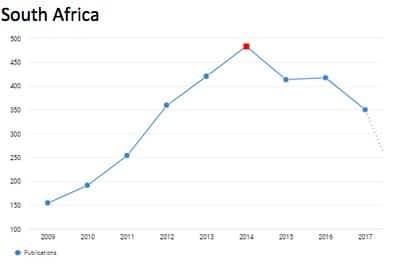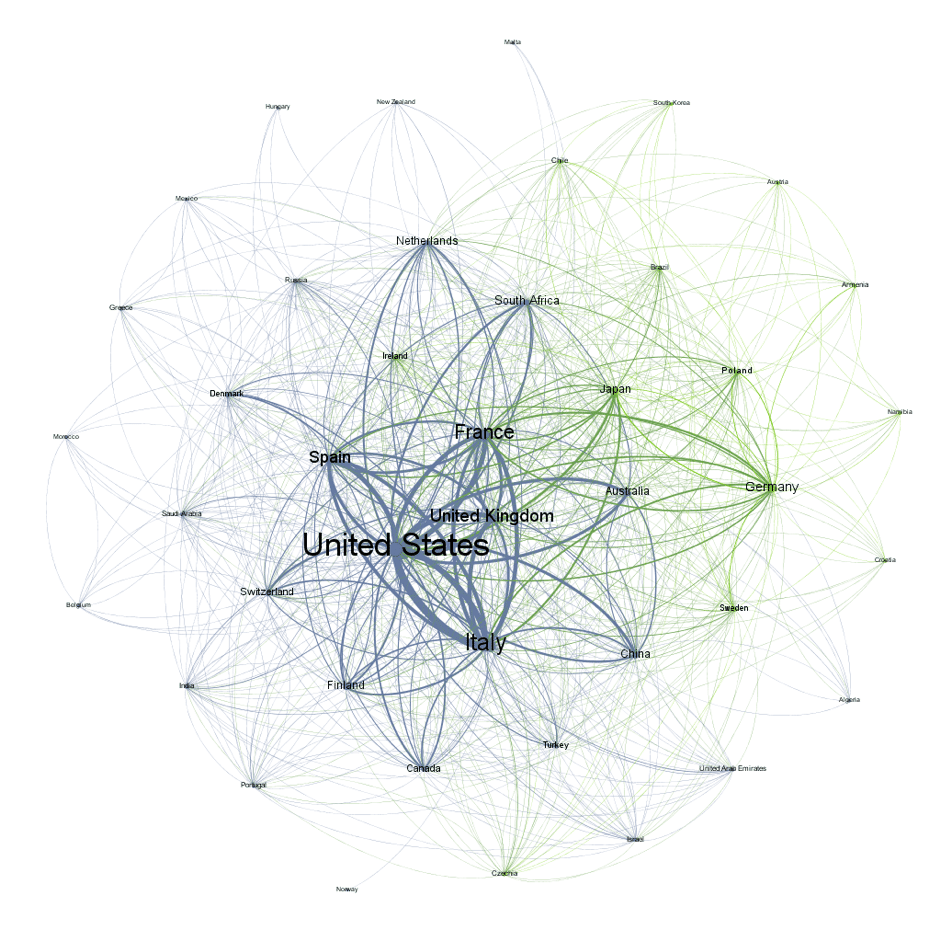Written by Thaiane Moreira De Oliveira, Dimensions Development Partner from the Universidade Federal Fluminense
In 2013, BRICS countries signed a Declaration in Cape Town, in which they committed to improving international cooperation programs in science, technology, and innovation (STI). The collaborative strategy focuses on five strategic thematic areas:
- Climate change and mitigation of catastrophes (Brazil)
- Water resources and pollution treatment (Russia)
- Geospatial technology and its applications (India)
- New and renewable energy, and energy efficiency (China)
- Astronomy (South Africa)
Five years after signing the declaration and nearly a decade after the inaugural BRICS Summit, evaluating the initiative to strengthen international cooperation among countries remains a challenge. This is largely due to their low presence in the large index databases commonly used for the collection of scientific data.
Given this panorama of low representation of countries outside the hegemonic axis (as discussed by Nwagwu), primarily a result of distorted and skewed proportions, it becomes necessary to seek other ways of measuring scientific data beyond the bases traditionally used for extracting data from the scientific production of semi-peripheral and peripheral countries. It is in this sense that the Dimensions platform has become an important alternative to other existing platforms in the space as discussed in more depth in this article by Michael Thelwall.
For this, the scientific and patent data was collected between the years 2014 to 2018, using the following keywords in the titles and abstracts: “climate change,” for Brazil; “Water resources” or “pollution treatment,” for Russia; “Geospatial technology,” for India; “Renewable energy,” for China; and “Astronomy,” for South Africa.

From the results presented, it is worth highlighting the proportion of production in Open Access, taking into account its relevance to balancing inequalities in the visibility of scientific production on a global scale. As we can observe, Brazil and South Africa appear as the largest producers of Open Access, much due to the success of Scielo’s presence in these countries.



While Brazil, Russia and China have increased production in the thematic axes defined in Cape Town, India experienced a fluctuation in production on geospatial technology in 2015, recovering in the following years, while South Africa has been showing declining production in astronomy since the year of the signing of the declaration.
Social network analysis
This analysis recognizes the importance of the standardization of social ties in which the stakeholders involved have important consequences for other parties with whom an interaction is established. Therefore, social network analysis was chosen to provide an approach that helps determine the interactional patterns established and to understand their consequences.
After the extraction of the raw data, the research networks were generated based on the worksheet generated by Dimensions. The categorization of the data for the formation of the co-author networks required processing through the R language, using IDE RStudio. Each article in the database contained information on the countries of their authors, who were reorganized in order to create relations between their respective countries, so that all the countries of the co-authors had connections between them. The Gephi software was used to visualize the co-authorship networks, in which each node represents a country and the edge is the link between these two nodes (countries).

In the graph generated from Brazilian productions on climate change, it is possible to observe a centrality of the United States over the co-authorship network. One of the possibilities of analyzing network graphs of co-authorship is to draw inferences on the contexts behind the visualization generated. In the Brazilian case, it is important to emphasize a process of Americanization of science following World War II, as discussed by Haney, particularly during the Brazilian military regime, between 1964 and 1989.
It should be noted that there is a direct relationship between the co-authorship networks and the international investment in research. For example, the development institutions that made the most investment in climate change research in Brazil include the National Council for Scientific and Technological Development (Brazil), the Research Support Foundation of the State of São Paulo (Brazil), and the United States Department of the Navy (United States), Brazil and the United States being the two countries with the greatest diversity of relationships in the network.

As in Brazil, the countries that stand out by the frequency of co-authorship on water resources in Russia are those that have had investment through development subsidies, such as China and the United States, as well as Russia itself, although the highest intensity is in the relationship with Germany. The agencies that most invested in research on water resources in Russia were the Russian Science Foundation (Russia), the National Aeronautics and Space Administration (NASA, United States), and the National Nature Science Foundation of China (China), among the 62 grants collected through Dimensions platform.
This network is in line with the findings of Glänzel on national characteristics in national co-authorship relations in several countries. According to his study, Glänzel noted that Germany proved to be a very important partner for most countries, especially for Austria, Hungary, Poland, and Russia, while Russia presents itself as an important partner for several Eastern and Western European countries. Although the findings of Glänzel, the network with Russia shows that this is a country of great diversity of articulation and interaction, becoming an important stakeholder both with Eastern and Western Europe, Asia, and North America, showing its potential of scientific influence and international articulation.
Figure 18: Graph generated in Gephi from data obtained in the Dimensions platform.

Unlike the other networks investigated in the BRICS countries, India has a less diverse, self-centered network, showing little international co-authorship. The data does not match with the scientific production of India, in particular in the field of space geotechnology. Particularly interesting as the country is considered one of the world’s major powers in the production and development of information technology, with strong political, social and administrative investments, defining it as a priority sector in the past 10 years, as discussed by Gupta and Dhawan.
It should be noted that Dimensions uses the Crossref database, extracting information from the scientific production whose Digital Object Identifier has been validated. Because the collection has returned a low production number, a more in-depth study is required to understand the ways of preserving digital data from persistent addresses in India.
China
China has emerged as one of the leading nations in world scientific production, growing exponentially in the number of publications co-authored with other countries in the world, behind only the United States (Zhou, Leydesdorff, 2006), which appears in data collected for the country with the largest bilateral relationship, as can be seen in the graph. Nevertheless, in spite of the strong relationship with the United States, unlike Brazil, the network is centered around China itself, strengthening the country’s scientific production, which tends to become a knowledge-based economy after large investments in public innovation and scientific policies. In addition to a strategic investment in areas considered priority, in line with the thematic areas agreed for China in the Cape Town Declaration, China’s investments in the renewable energy and new energy sectors appear from two central stakeholders emerging in the graph: China, through the agencies University Grands Committee (UGC), National Natural Science Foundation of China (NSFC), and Innovation and Technology Commission (ITC); and the United States, through the Advanced Research Projects Agency-Energy (ARPA-E).
South Africa

As in Brazil, there is a high degree of co-authorship with United States and United Kingdom, reflecting a process imposed by that British colonization. This affects not only language but also the dynamics of scientific production, as well as the process of recolonization and Americanization of knowledge, as experienced in Latin America. Like India, the low return on data collection may indicate a lack of investment in persistent data preservation and archiving policies, such as DOI, which requires a more thorough examination of the cultural and social dynamics of scientific publication in the country.
Despite the high percentage of open-access publications (37.78%), this is a recent movement, with few national public policies aimed at encouraging the production and dissemination of knowledge (Czerniewicz and Goodier, 2014; Goodier, Czerniewicz, 2014), which makes it important to highlight important initiatives in South Africa that already point to the quantity of open-access productions in the country. One of them is SciELO-SA, an initiative funded by the Department of Science and Technology (DST) and the Department of Higher Education and Training (DHET), which currently features 75 South African journals. The second initiative worth mentioning is the recent launch of Africarxiv, a preprint repository developed by the Open Science Center (COS), which will promote scientific knowledge in African countries in various scientific fields.
These two initiatives already point to a significant cultural change in terms of dissemination of knowledge in the country. A study published in 2013 showed an invisibility through a Google query for research in South Africa in an area where it is known that much research has been carried out, such as Astronomy.
Final considerations
The BRICS countries, despite cultural, linguistic and economic differences, were among the leading emerging national economies, distinguishing themselves by their rapid and heterogeneous growth The Cape Town Declaration, signed in 2013, showed the countries’ consent to the role of science as a promoter of economic and social development.
In this research, we argue that the delegation of research and researchers of equal importance to places different from the system of scientific prestige is largely due to contemporary geopolitical dynamics. These dynamics delegate to the United States and Western Europe a central and privileged role in the current scientific ecosystem. As seen in this work, the centrality of the United States in Brazilian, Russian and South African networks is exemplary.
With the understanding that the scientific ecosystem is not limited to the practice of production and consumption of scientific productions, such as publication and quotation, but rather to a complex integrated system, it becomes necessary to integrate other elements to promote a holistic view on an interdependent set of scientific stakeholders. The ecosystem analogy used here concerns the recognition of mutual interdependencies between different stakeholders involved in the production of knowledge. The knowledge production chain is not only limited to a set of researchers who publish their work, but also a network of economic, political and social groups that directly affect scientific and technological production, such as funding from development agencies, research agendas, the relationship between researchers and national and international research groups.
To understand the complex scientific ecosystem, it does not suffice to look only at citations, publication scores, career movements, academic awards or other generic measures that account for merely one sphere of the set of stakeholders that compose an environment of dispute and survival. It is necessary to look at scientific and technological production, it is understood as resulting from interactions between research institutions and, mainly, from investment by national or international financial agencies, which directly affect the scientific production process. And Dimensions helps provide a holistic view of the whole scientific ecosystem, as we discuss in the full paper: https://osf.io/preprints/socarxiv/b6x43/
